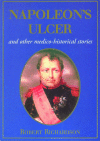I was lured into reviewing this book under false pretences. All that was mentioned in the request was the most famous gastric ulcer in history – surely a gastroenterologist would be the ideal candidate to review such a book? With no more information than the first line of the title, I naively agreed. The nicely presented package arrived resplendent with a glossy cover endowed with a portrait of the great man and embossed with the headline title in bold gold lettering. Only then did the first question simmer in my sub-conscious: Why the sub-title ‘and other medico-historical stories’? The reputable book editor of this esteemed journal mentioned nothing other than gastric ulceration!
Let us begin with the ulcer, which takes up the introductory chapters of the book. I confess that I had limited knowledge of Napoleon's predicament prior to this review and I have emerged much the wiser (or at least better informed). However, not for the last time in this review process, I found myself confused. Was I reading a detective story requiring a solution? Or was it being presented as a clinical case history for medical analysis? Or was it a fantasy based on speculation? I struggled to know which role the author wanted it to fulfil. What I did enjoy in these early chapters was the information conveyed about the state of knowledge at that time regarding ulcer disease. They did not have to worry about breath tests and helicobacter pylori.
Just as I was engaging with Napoleon and finding myself speculating about whether or not he had H. pylori, Napoleon is gone. Not just dead and dissected but by page 41 of 226, his presence left this scene of time; or at the very least the pages of this book. And guess what comes next?
One turns over the page anticipating more on Napoleon or perhaps his doctor (who is to feature later), or some treatise on other famous ulcers or anything but the menopause. The menopause? Yet that is the non-sequitur that “sequiturs”. Hence the second question I have with this book: What is its purpose? How does it hang together? What is the common thread? Where are we going? (Four questions, I know…)
But back to the story of the menopause. Here we find such useful comments from history as “woman is a pair of ovaries with a human attached” (Virchow) and Galen's view that menses were simply the natural blood-letting necessitated by overeating. Here we begin to see the virtue of the book. It is a book full of quotes and anecdotes to be used in appropriate circumstances, dropped into the conversation to impress the dinner party, thrown out in lectures to medical students to maintain interest.
If you were looking for an unusual angle on your chosen field of medical expertise, the chances are you will find it in this book. Provided of course your chosen field is one of the eclectic topics covered within it. Having said that, it is hard to envisage the use of either of the above quotations in any circumstance that would not result in a lynching of the utterer.
However the fact that Roman sailors only cut their hair during a storm and that French physiologists injected themselves with canine testicular extract in the pursuit of eternal youth must have value and interest to some discerning readers.
For an enjoyable historical read, the chapter on Larrey is the most enlightening. In this chapter a historical tale is told that engages the reader and leaves him admiring a multi-talented but flawed man. That is a good “medico-historical” chapter that fulfils the promise of the book's subtitle. However that chapter only highlights my third question: Is this book really “medico-historical” as it claims? Chapters such as those on blood have more to do with mythology than history. Other chapters on hair, death and transplantation lean towards psycho-analysis and philosophy. Mind you, I am still not sure about the castration complex and its link with hair.
I can tolerate psychology, I enjoy history and I love mythology but I keep coming back to the question now burning into my consciousness: What is the purpose of this book? What is it trying to be?
Only when we come to the last page of the book do we learn the secret. The page that solves the riddle comes after the book has ended, after the index, and at the end of a series of pages advertising books by the same author. Finally, an answer to the purpose of the book; finally a link that binds the apparently un-associated! The solution is a novel previously written by the author; a novel that spans all the epochs referred to in this tome; a novel in which the hero visits the historical characters of this book. This current book is the back-text of that novel. Perhaps next time I will be asked to review the novel.



